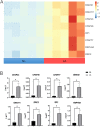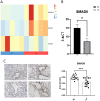The underlying molecular mechanism of ciliated epithelium dysfunction and TGF-β signaling in children with congenital pulmonary airway malformations
- PMID: 38396057
- PMCID: PMC10891104
- DOI: 10.1038/s41598-024-54924-x
The underlying molecular mechanism of ciliated epithelium dysfunction and TGF-β signaling in children with congenital pulmonary airway malformations
Abstract
The aim of this study was to investigate the variation in gene expression in the complete transcripts of Congenitalpulmonary airwaymalformation (CPAM) of the lung using Next Generation Sequencing (NGS) technology. There were 20 cases involving children with CPAM were used for selection of study sample. NGS was used to establish RNA-Seq libraries for the two groups of samples separately, and both groups were conducted to differential expression analysis and Gene Ontology (GO) functional enrichment analysis. The pathways of the differential genes were analyzed to find the enriched target pathways. A total of 592 genes were expressed with significant differences (CPAM vs. normal tissue, P < 0.05). GO functional analysis of DEGs indicated that abnormal ciliary function played a role in the development of CPAM. Subsequently, analysis of these genes pathways showed the TGF-β signaling pathway was significantly enriched. Finally, the results of immunohistochemical analysis of some DEGs showed that a significant reduction in the expression of SMAD6, a gene related to the TGF-β signaling pathway, led to abnormal activation of the pathway. TGF-β signaling pathway involved in the evolution of the disease obtained by DEGs enrichment pathway analysis. SMAD6, a gene involved in this pathway, might be a potential biomarker for the diagnosis and treatment of CPAM.
Keywords: Congenital pulmonary malformation; RNA-Seq; SMAD6; TGF-β.
© 2024. The Author(s).
Conflict of interest statement
All authors have no potential conflicts of interest with any companies/organizations whose products or services may be discussed in this article.
Figures






Similar articles
-
Integrated bulk and single-cell RNA-sequencing reveals SPOCK2 as a novel biomarker gene in the development of congenital pulmonary airway malformation.Respir Res. 2023 May 10;24(1):127. doi: 10.1186/s12931-023-02436-z. Respir Res. 2023. PMID: 37165378 Free PMC article.
-
Application of second-generation sequencing in congenital pulmonary airway malformations.Sci Rep. 2022 Nov 28;12(1):20459. doi: 10.1038/s41598-022-24858-3. Sci Rep. 2022. PMID: 36443638 Free PMC article.
-
Global interpretation of novel alternative splicing events in human congenital pulmonary airway malformations: A pilot study.J Cell Biochem. 2022 Apr;123(4):736-745. doi: 10.1002/jcb.30216. Epub 2022 Jan 22. J Cell Biochem. 2022. PMID: 35064685
-
Congenital pulmonary airway malformations: state-of-the-art review for pediatrician's use.Eur J Pediatr. 2017 Dec;176(12):1559-1571. doi: 10.1007/s00431-017-3032-7. Epub 2017 Oct 19. Eur J Pediatr. 2017. PMID: 29046943 Review.
-
Congenital Pulmonary Airway Malformations With a Reconsideration and Current Perspective on the Stocker Classification.Pediatr Dev Pathol. 2023 May-Jun;26(3):241-249. doi: 10.1177/10935266221146823. Epub 2023 Feb 21. Pediatr Dev Pathol. 2023. PMID: 37334833 Review.
Cited by
-
Integrative analysis of bulk and single-cell RNA sequencing reveals the gene expression profile and the critical signaling pathways of type II CPAM.Cell Biosci. 2024 Jul 18;14(1):94. doi: 10.1186/s13578-024-01276-8. Cell Biosci. 2024. PMID: 39026356 Free PMC article.
References
-
- Boucherat O, Jeannotte L, Hadchouel A, Delacourt C, Benachi A. Pathomechanisms of congenital cystic lung diseases: Focus on congenital cystic adenomatoid malformation and pleuropulmonary blastoma. Paediatr. Respir. Rev. 2016;19:62–68. - PubMed
-
- Hardee S, Tuzovic L, Silva CT, Cowles RA, Copel J, Morotti RA. Congenital cystic lung lesions: Evolution from in-utero detection to pathology diagnosis-a multidisciplinary approach. Pediatr. Dev. Pathol. Off. J. Soc. Pediatr. Pathol. Paediatr. Pathol. Soc. 2017;20(5):403–410. doi: 10.1177/1093526617698604. - DOI - PubMed
MeSH terms
Substances
Grants and funding
LinkOut - more resources
Full Text Sources

